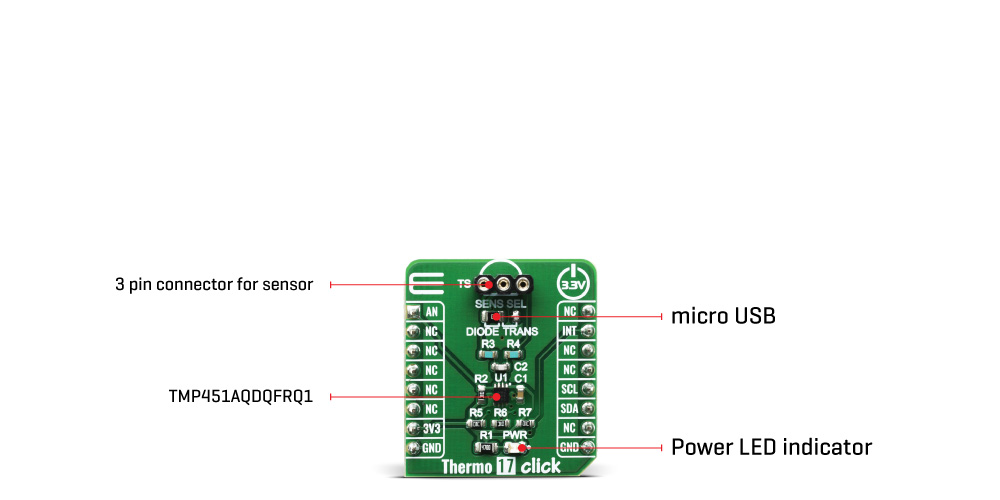



Overview
The Thermo 17 Click Board™is based on the TMP451-Q1, a high-accuracy, low-power remote temperature sensor monitor with a built-in local temperature sensor from Texas Instruments. Because of its main features, this Click Board™ is perfect for automotive infotainment systems, ECU processor temperature monitoring, TCM processor temperature monitoring, BCM processor temperature monitoring and LED headlight thermal control.
The Thermo 17 Click Board™ is supported by a mikroSDK compliant library, which includes functions that simplify software development. This Click Board™ comes as a fully tested product, ready to be used on a system equipped with the mikroBUS™ socket.
Downloads
How Does The Thermo 17 Click Board™ Work?
The Thermo 17 Click Board™ is equipped with the TMP451-Q1 sensor IC, which can measure temperature measurements between -40°C and +125°C so that the temperature measurement data can be processed by the host MCU. The remote temperature sensors are typically low-cost discrete NPN or PNP transistors, or substrate thermal transistors or diodes that are integral parts of microprocessors, microcontrollers, or FPGAs.

The temperature is represented as a 12-bit digital code for both the local and the remote sensors, giving a resolution of 0.0625°C. The temperature accuracy is ±1°C (maximum) in the typical operating range for the local and the remote temperature sensors. The two-wire serial interface accepts the SMBus communication protocol. Advanced features such as series resistance cancellation, programmable nonideality factor (ηfactor), programmable offset, programmable temperature limits, and a programmable digital filter are combined to provide a robust thermal monitoring solution with improved accuracy and noise immunity. The TMP451-Q1 device is ideal for multi-location, high-accuracy temperature measurements in a variety of automotive sub-systems. The device is specified for operation over a supply voltage range of 1.7 V to 3.6 V and a temperature range of –40°C to 125°C.
Because of its main features, this Click Board™ is perfect for automotive infotainment systems, ECU processor temperature monitoring, TCM processor temperature monitoring, BCM processor temperature monitoring and LED headlight thermal control.
The TMP451-Q1 device operates only as a slave device on either the two-wire bus or the SMBus. Connections to either bus are made using the open-drain I/O lines, SDA and SCL. The SDA and SCL pins feature integrated spike suppression filters and Schmitt triggers to minimize the effects of input spikes and bus noise.
The Thermo 17 Click Board™ is designed to be operated only with 3.3V logic level. A proper logic voltage level conversion should be performed before the Click Board™ is used with MCUs with logic levels of 5V.
SPECIFICATIONS
| Type | Temperature & humidity |
| Applications | Automotive infotainment systems, ECU processor temperature monitoring, TCM processor temperature monitoring, BCM processor temperature monitoring and LED headlight thermal control |
| On-board modules | TMP451-Q1, a high-accuracy, lowpower remote temperature sensor monitor with a built-in local temperature sensor from Texas Instruments |
| Key Features | Qualified for automotive applications, Series resistance cancellation, Programmable digital filter |
| Interface | GPIO,I2C |
| Compatibility | mikroBUS |
| Click Board™ size | S (28.6 x 25.4 mm) |
| Input Voltage | 3.3V |
PINOUT DIAGRAM
This table shows how the pinout on the Thermo 17 Click Board™ corresponds to the pinout on the mikroBUS socket (the latter shown in the two middle columns).
| Notes | Pin |  |
Pin | Notes | |||
|---|---|---|---|---|---|---|---|
| Termal shutdown | AN | 1 | AN | PWM | 16 | NC | |
| NC | 2 | RST | INT | 15 | INT | Interrupt output | |
| NC | 3 | CS | RX | 14 | NC | ||
| NC | 4 | SCK | TX | 13 | NC | ||
| NC | 5 | MISO | SCL | 12 | SCL | I2C Clock | |
| NC | 6 | MOSI | SDA | 11 | SDA | I2C Data | |
| Power Supply | 3.3V | 7 | 3.3V | 5V | 10 | NC | |
| Ground | GND | 8 | GND | GND | 9 | GND | Ground |
ONBOARD SETTINGS AND INDICATORS
| Label | Name | Default | Description |
|---|---|---|---|
| LD1 | PWR | - | Power LED Indicator |
| JP1 | SEN SEL | Left | Sensor selection: Left position DIODE, Right side TRANSISTOR |
| General Information | |
|---|---|
Part Number (SKU) |
MIKROE-3994
|
Manufacturer |
|
| Physical and Mechanical | |
Weight |
0.016 kg
|
| Other | |
Country of Origin |
|
HS Code Customs Tariff code
|
|
EAN |
8606018718412
|
Warranty |
|
Frequently Asked Questions
Have a Question?
Be the first to ask a question about this.




